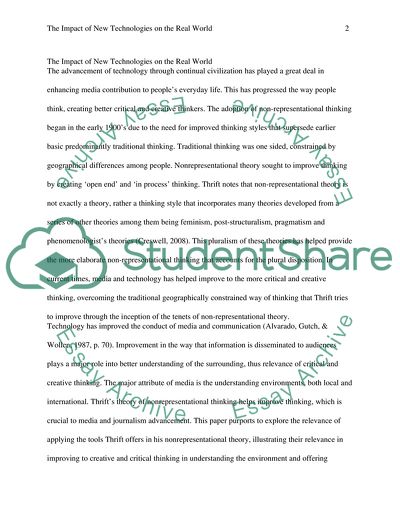Cite this document
(The Impact of New Technologies on the Real World Essay Example | Topics and Well Written Essays - 3000 words, n.d.)
The Impact of New Technologies on the Real World Essay Example | Topics and Well Written Essays - 3000 words. https://studentshare.org/journalism-communication/1821377-outline-the-7-tenets-of-non-representational-theory-as-set-out-in-by-nigel-thrift-comment-on-each-and-illustrate-with-examples-of-the-ways-in-which-new-technologies-have-impacted-on-the-real-world
The Impact of New Technologies on the Real World Essay Example | Topics and Well Written Essays - 3000 words. https://studentshare.org/journalism-communication/1821377-outline-the-7-tenets-of-non-representational-theory-as-set-out-in-by-nigel-thrift-comment-on-each-and-illustrate-with-examples-of-the-ways-in-which-new-technologies-have-impacted-on-the-real-world
(The Impact of New Technologies on the Real World Essay Example | Topics and Well Written Essays - 3000 Words)
The Impact of New Technologies on the Real World Essay Example | Topics and Well Written Essays - 3000 Words. https://studentshare.org/journalism-communication/1821377-outline-the-7-tenets-of-non-representational-theory-as-set-out-in-by-nigel-thrift-comment-on-each-and-illustrate-with-examples-of-the-ways-in-which-new-technologies-have-impacted-on-the-real-world.
The Impact of New Technologies on the Real World Essay Example | Topics and Well Written Essays - 3000 Words. https://studentshare.org/journalism-communication/1821377-outline-the-7-tenets-of-non-representational-theory-as-set-out-in-by-nigel-thrift-comment-on-each-and-illustrate-with-examples-of-the-ways-in-which-new-technologies-have-impacted-on-the-real-world.
“The Impact of New Technologies on the Real World Essay Example | Topics and Well Written Essays - 3000 Words”. https://studentshare.org/journalism-communication/1821377-outline-the-7-tenets-of-non-representational-theory-as-set-out-in-by-nigel-thrift-comment-on-each-and-illustrate-with-examples-of-the-ways-in-which-new-technologies-have-impacted-on-the-real-world.


